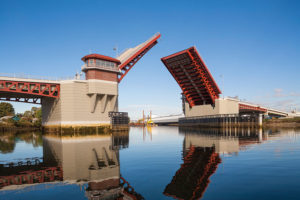HNTB Corporation was an Outstanding Award Winner for its South Park Bascule Bridge Replacement in the 2015 NCSEA Annual Excellence in Structural Engineering Awards Program in the Category – New Bridges and Transportation Structures.
When HNTB designed the new first-of-its-kind South Park Bridge in Seattle, the goal was to make the structure something that would provide excellent service to area residents and make them proud.
HNTB was awarded the final design contract in 2008. Final funding was secured in 2010 and construction got underway in 2011. Completed and opened to traffic on June 30, 2014, it is the first bascule bridge designed to meet strict post-seismic operational requirements in an AASHTO Seismic Zone 4 with 70- to 105-foot-deep soft soils.
Among numerous project challenges, the most significant were:
- Designing a movable span in a seismically volatile region.
- Designing for enhanced maintainability and reliability.
- Keeping the community involved during high-impact periods of the project.
- Preserving the historic features of the original bridge.
- Designing and building an environmentally responsible project.
The original South Park Bridge, constructed in 1931, was a double-leaf bascule bridge listed on the National Register of Historic Places and designated a King County Landmark. The 1,045-foot-long bridge spanned the Duwamish Waterway and connected the industrial South Park area and downtown Seattle.
The closure of the old bridge in June 2010 occurred earlier than scheduled because of safety issues. The main piers were settling and tilting in an unpredictable manner due to the original foundation piles not penetrating through a deep layer of liquefiable soil, as well as the concrete structure having been weakened by several earthquakes. In its last years of operation, the bridge required extensive maintenance operations to maintain alignment of the movable spans and machinery.
Designing the new bridge to be fully functional after an Operational Level (108-year return) earthquake and experience only moderate, repairable damage during a Design Level (975-year return) earthquake was unprecedented. HNTB designed several innovative solutions to meet stringent seismic performance requirements, including sunken caisson foundations, isolated trunnion frames, and collapsible center joints on draw spans.
Compared to drilled shaft foundations, the sunken caissons provide enhanced stiffness and resilience, reducing seismically induced displacements.
Each bascule leaf and its machinery are supported on a free-standing steel trunnion frame inside each pier that is designed to respond elastically at the higher level event. During an earthquake, the machinery and bascule leaf move together as one. Relative displacements between components after an earthquake are small, preventing machinery damage.
At mid-span, where the two tips of the movable spans come together, a gap measuring 18 inches just under the expansion joint plates prevents contact between the steel framework of the leaves during the higher-level event. This minimizes the transfer of loads to the trunnion frames in each pier and economizes the design of the trunnion frames and bearings. Above, on the driving surface, large joint plates which are only a few inches apart are minimally secured to the bridge so that they become sacrificial if the leaves come into contact with each other.
The main girders, comprising one of the most prominent and unique elements of the bridge, are believed to be the first known use of a “trussed” web girder. The continuous welded plate construction eliminates gusset plates and thousands of fasteners, and will significantly improve future inspection, bridge maintenance, and safety.
Key cost-effective aspects of the $167 million project include the repurposing of materials and elements of the original bridge and a decorative rain garden that serves as landscape art while collecting. Also, the rain garden naturally treats storm water runoff from the bridge before discharging it into the waterway. The inclusion of a rain garden eliminated the need to install an enormous and expensive underground detention vault.
Besides promoting cost effectiveness, repurposing materials from the old bridge and creating a rain garden enhanced the project from the standpoint of environmental responsibility. The rain garden’s park-like setting was also a benefit to the community.
At the same time, incorporating elements of the old bridge preserved historic aspects of that structure that the community was fond of. As one the few working examples of an original Scherzer Rolling Lift Bridge, the old bridge had been listed on the National Register of Historic Places and had received historic landmark designation from the King County Landmarks Commission.
Public outreach was prevalent throughout the entire project with a series of electronic updates, regular public meetings and door-to-door visits to key businesses along the closed corridor. Extensive outreach continued during construction and played a significant part in the acceptance of the project despite four years of disruption.
From the innovation and expertise of HNTB’s design at the beginning to the conscientious effort to ensure construction was of the highest quality, this bridge exceeded expectations. Everyone involved put their hearts into this project, and that care is reflected in what stands out there now and for the next 100 years.▪

